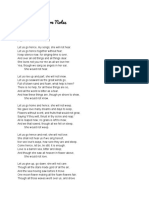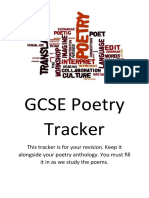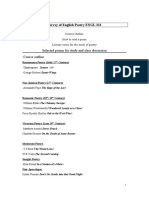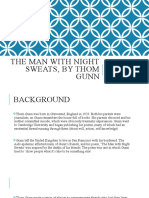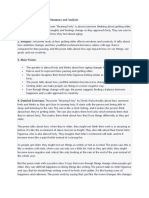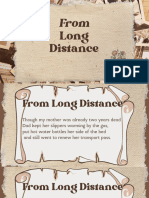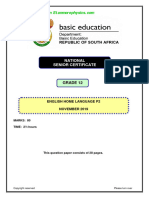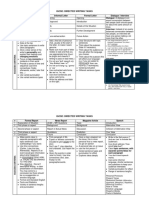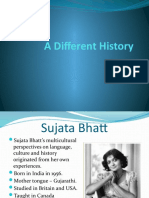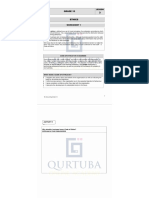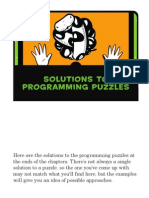Analysing Unseen Poetry
Analysing Unseen Poetry
Uploaded by
Asma GaniCopyright:
Available Formats
Analysing Unseen Poetry
Analysing Unseen Poetry
Uploaded by
Asma GaniOriginal Title
Copyright
Available Formats
Share this document
Did you find this document useful?
Is this content inappropriate?
Copyright:
Available Formats
Analysing Unseen Poetry
Analysing Unseen Poetry
Uploaded by
Asma GaniCopyright:
Available Formats
Analysing Unseen Poetry
As part of your Literature studies, for English you are
required to be able to Analyse and make meaning of a poem
termed ‘unseen’. Students usually dread the ‘unseen poetry
that appears in the Literature paper, however, by following
the steps below the exercise can be made both enjoyable
and stress free.
How do you analyse poetry?
The following Spider diagram serves as good summary of
the steps involved in the process of analysis. Remember to
follow the steps below keeping in hand your tools
(highlighters, colour pens or pencils):
Image from Poetry resource pack GDE
A detailed explanation of the above diagram is found below:
Step 1
Look at the title and try to predict what the poem is about.
Look at the form of the poem. How many stanzas are there?
How many lines are there in each stanza? Is the poem in a
special shape? If so, does the shape mean anything?
Step 2
Read the poem 'aloud' to yourself in your head. Imagine you
are reading it out loud (but don't actually do it or you might
get
into trouble). This is very important because it will help you to
notice the rhythm and the rhyme in the poem.
DON'T PANIC IF YOU SEE WORDS YOU DON'T KNOW IN
UNSEEN POEMS !
You can usually guess them by looking at the other words.
Step 3
Think about who the 'speaker' is? Is the poem written
through the poet's eyes or is it written in the third person
(he/she).
These are the voices of the poem.
Step 4
Think about the main subject of the poem. You need to think
about the setting and the situation.
Step 5
Look at the choice of words. Are they negative or positive?
Are there any ideas that are repeated? This will help you to
identify themes (such as nature). Remember not to panic if
there are words you don't know.
Step 6
Look at the rhyme and rhythm of the poem,
Does the poem rhyme? What is the rhyming pattern? (e.g.
ABAB or ABCB etc.)
Why do you think the poet has chosen this rhyme/rhythm to
express his ideas?
Do the sound and rhythm of the lines seem light and bouncy,
or do the lines move more slowly with heavy rounded sounds
and
a slow rhythm? Are the sounds and rhythms different at
different places in the poem?
Step 7
Identify any poetic devices such as metaphors, similes and
personification. How do they affect the meaning of the
poem?
Do they make it stronger?
Step 8
Look for imagery - descriptive language that 'paints a
picture' in the reader's mind.
What are the main images (pictures) the poet uses? Look
closely for metaphors, similes and personification
Which images are particularly striking? Why?
Are there parts of the poem that ask you to use your senses of
hearing, sight, smell, touch or taste?
Step 9
Look at the mood of the poem.
What is the mood or tone of the poem? Does it feel happy,
sad, angry, surprised or any other emotions?
Is the poem trying to teach you something, persuade you,
touch you, entertain you or whatever?
How does the poet feel about the subject of the poem?
Step 10
Lastly, what message is the poem giving? Are there any
deeper meanings? What can you learn from the poem?
How is the message conveyed?
What is your personal response to the poem?
How did you react to the poem?
Did it touch you?
Did it make you think about an issue more deeply, or from a
different point of view?
Do you think the poem is effective? Why?
The next question students usually ask is, “ Can I condense
these 10 steps?” The answer is yes.
The 10 step method can be summarised into 5 steps as
shown below:
FIVE STEPS TO ANALYSING AN
UNSEEN POEM
STEP ONE: Work out what the poem is about...
What is the subject of the poem?
Who is speaking?
Who is the narrator speaking to?
STEP TWO: Identify the themes and message of the poem...
Why has the poet written the poem?
What are they trying to say?
What ideas are they using?
Is it an emotional response to something that’s happened?
Is it trying to get an emotional response from the reader?
Is it portraying a message or opinion on a subject or event?
STEP THREE: Identify the attitudes and feelings in the poem...
What are the different emotions and feelings of the narrator
or poet?
What is the mood or atmosphere of the poem (e.g. sad,
angry, etc.)?
How has the poet used different poetic techniques to show
these attitudes
and feelings?
STEP FOUR: Identify the poetic techniques used in the
poem...
What are the different poetic techniques that the poet has
used to show
the attitudes and feelings in the poem?
How has the poet shown these feelings through form and
structure (e.g. rhyme, rhythm, line length, stanza length,
etc.)?
How has the poet used poetic devices to show these feelings
(e.g. metaphors, similes, caesura, enjambment, alliteration,
juxtaposition, personification, etc.)?
STEP FIVE: Explore your personal response to the poem...
How do you feel about the poem?
How well does the poet get the message across in the
poem?
What is the impact of the poem on the reader (refer to ‘the
reader’, rather
than ‘I’ when talking about the impact of the poem)?
Are there any other ways the poem could be interpreted?
Activity:
Practise going through these steps with unseen poems over
and over again until you can do it in good time (you have 30
minutes to answer the question in the exam, so you should
take about 5-10 minutes reading and planning).
Here is a poem for you to look at and have a go at the 5 step
process with.
Read the poem A Wish for my Children by Evangeline
Paterson and answer the questions that follow.
On this doorstep I stand
year after year
to watch you going
and think: May you not
skin your knees. May you 5
not catch your fingers
in car doors. May
your hearts not break.
May tide and weather
wait for your coming 10
and may you grow strong
to break
all webs of my weaving.
1. Explain what is shown by the repetition in line ‘year
after year’. (2)
2. Refer to stanza 2. Comment on how a child’s
needs change as he/she grows. (2)
3. How does the image in stanza 3 show the change
in the relationship between mother and child? (3)
4. Refer to the last stanza and explain how it relates
to the wish expressed in the title of the poem. (3)
[10]
You might also like
- Study Work Guide: Poems From All Over Grade 11 Home LanguageFrom EverandStudy Work Guide: Poems From All Over Grade 11 Home LanguageRating: 3 out of 5 stars3/5 (2)
- Study Work Guide: Vistas of Poems Grade 11 First Additional LanguageFrom EverandStudy Work Guide: Vistas of Poems Grade 11 First Additional LanguageRating: 5 out of 5 stars5/5 (1)
- Sampurna Chattarji - BoxesDocument1 pageSampurna Chattarji - BoxesabschandruabsNo ratings yet
- NW English Fal Task 4 (Term 1 Test 1) Grade 12 Mg..Document13 pagesNW English Fal Task 4 (Term 1 Test 1) Grade 12 Mg..obakengmoshoeu8No ratings yet
- Poems On A Grid Grade 12Document9 pagesPoems On A Grid Grade 12Nomfundo ShabalalaNo ratings yet
- CNN RNN Assignment Set 4Document2 pagesCNN RNN Assignment Set 4Surendra Tanwar0% (1)
- Will It Be So Again - QuestionsDocument1 pageWill It Be So Again - Questionsmeghdyck100% (1)
- The Spirit Is Too Blunt An InstrumentDocument21 pagesThe Spirit Is Too Blunt An InstrumentnellytusiimeNo ratings yet
- Sonnet 73 AnnotationDocument1 pageSonnet 73 AnnotationMeheak0% (1)
- On Finding A Small Fly Crushed in A BookDocument19 pagesOn Finding A Small Fly Crushed in A BookVictoria Olutimehin100% (1)
- Unseen Poetry: Practice Exam QuestionsDocument37 pagesUnseen Poetry: Practice Exam QuestionsMarwa IqbalNo ratings yet
- 8a - An Unknown GirlDocument1 page8a - An Unknown GirlWilliam Burn67% (3)
- Unseen Paper 4 Tips IGCSE 0475Document6 pagesUnseen Paper 4 Tips IGCSE 0475Sumati Sachdev100% (2)
- Literary Analysis Essay - Response To Lit Essay Shorter VersionDocument2 pagesLiterary Analysis Essay - Response To Lit Essay Shorter Versionapi-262266786100% (1)
- Unseen-Poems (1) Edexcel Igcse English Language A Free Exam PracticeDocument10 pagesUnseen-Poems (1) Edexcel Igcse English Language A Free Exam PracticeZoonieFRNo ratings yet
- Language Features and Their EffectsDocument5 pagesLanguage Features and Their EffectsAsterisk KhantNo ratings yet
- Poetry Analysis Guide-08Document2 pagesPoetry Analysis Guide-08caffeine_cindy100% (3)
- Poetic Terms: Figures of SpeechDocument2 pagesPoetic Terms: Figures of SpeechDCHS_MrB100% (1)
- Poem Analysis - LamentDocument17 pagesPoem Analysis - LamentAlejandra Piazzolla100% (2)
- WWII Poster RubricDocument1 pageWWII Poster Rubricsteven_e_kleinNo ratings yet
- Japanese Postpositions: Theory and Practice - Noriko Katsuki-PestemerDocument160 pagesJapanese Postpositions: Theory and Practice - Noriko Katsuki-PestemerRigoberto MenchúNo ratings yet
- Unseen Poetry NotesDocument10 pagesUnseen Poetry NotesKanan100% (1)
- Unseen Poetry AnalysisDocument12 pagesUnseen Poetry Analysismorebandu2483No ratings yet
- IGCSE 0408 Unseen Poem QuestionsDocument5 pagesIGCSE 0408 Unseen Poem QuestionsMenon HariNo ratings yet
- Level L - Songs of Ourselves - Term Three - AY2324Document27 pagesLevel L - Songs of Ourselves - Term Three - AY2324Raneem DardasNo ratings yet
- I Look Into My GlassDocument11 pagesI Look Into My GlassPhang Pei Pei100% (1)
- Symbolism, Imaginary and Figurative LanguageDocument8 pagesSymbolism, Imaginary and Figurative LanguageFrancine Mae Tubianosa TebelinNo ratings yet
- Analysis of The Poem "Love Is Not All - It Is Not Meat or Drink" - (Essay Example), 1791 Words GradesFixerDocument3 pagesAnalysis of The Poem "Love Is Not All - It Is Not Meat or Drink" - (Essay Example), 1791 Words GradesFixerHugues HaroldNo ratings yet
- English Literature Notes A Leave TakingDocument10 pagesEnglish Literature Notes A Leave TakingElie aNo ratings yet
- GCSE Poetry TrackerDocument17 pagesGCSE Poetry TrackerSofia NietoNo ratings yet
- Selected Poems For StudyDocument50 pagesSelected Poems For StudysamaaliNo ratings yet
- Kinds of Poetry: 1-PastrolDocument3 pagesKinds of Poetry: 1-Pastrolhodhod2No ratings yet
- African Thunderstorm QuestionsDocument7 pagesAfrican Thunderstorm Questionsseamus heaneyNo ratings yet
- The Man With Night Sweats, by ThomDocument11 pagesThe Man With Night Sweats, by ThomNokukhanya HlabanganaNo ratings yet
- Analysis: A Birthday by Christina RossettiDocument12 pagesAnalysis: A Birthday by Christina RossettiAhmed PatelNo ratings yet
- Young and Dyslexic AnalysisDocument2 pagesYoung and Dyslexic AnalysisKawsar Jahan Akhi100% (2)
- How To Approach An IGCSE Text Analysis StudentDocument4 pagesHow To Approach An IGCSE Text Analysis StudentEugene Joseph100% (1)
- Cambridge IGCSE: Literature in English 0475/12Document23 pagesCambridge IGCSE: Literature in English 0475/12Chamith KarunadharaNo ratings yet
- On Turning Ten by Billy CollinsDocument17 pagesOn Turning Ten by Billy Collinsnarin zakarianNo ratings yet
- Nearing FortyDocument4 pagesNearing FortyMuhammad FaheemNo ratings yet
- An Unknown GirlDocument1 pageAn Unknown GirlJason Lee100% (2)
- Life of Pi EssaysDocument3 pagesLife of Pi EssaysHamza Saley100% (1)
- A Walk To The JettyDocument1 pageA Walk To The JettysarrameeraliNo ratings yet
- Chinese CinderellaDocument5 pagesChinese CinderellaKopano LetsatsiNo ratings yet
- English - NotesDocument24 pagesEnglish - Notesdagakabbier1718No ratings yet
- Cambridge IGCSE: Literature (English) (Us) 0427/02Document8 pagesCambridge IGCSE: Literature (English) (Us) 0427/02priyangNo ratings yet
- From Long Distance Literary AnalysisDocument13 pagesFrom Long Distance Literary AnalysisenyonamampNo ratings yet
- English HL Nov 2019 P2 and MemoDocument54 pagesEnglish HL Nov 2019 P2 and Memopkkena05No ratings yet
- Figures of SpeechDocument23 pagesFigures of SpeechSelino Cruz100% (1)
- Chinese Cinderella: Analysis/AnnotationsDocument1 pageChinese Cinderella: Analysis/Annotationsnaduni0% (1)
- English HL P2 Nov 2010Document22 pagesEnglish HL P2 Nov 2010Pranav SewpersadNo ratings yet
- Lament Worksheet Answers 03-Feb-2012Document5 pagesLament Worksheet Answers 03-Feb-2012Wendy ChanNo ratings yet
- Funeral BluesDocument2 pagesFuneral BluesMarco Briosa100% (1)
- Mock Exam Paper 3 ExamsDocument17 pagesMock Exam Paper 3 Examspierrette1100% (1)
- He Never Expected Much PoemDocument1 pageHe Never Expected Much PoemMUHAMMAD ISA ALI 10927No ratings yet
- Directed Writing Tasks Success CriteriaDocument2 pagesDirected Writing Tasks Success CriteriaMaya Malanum100% (3)
- A Different History - Sujata BhattDocument11 pagesA Different History - Sujata Bhattsumathi narayanan100% (3)
- Valentine by Carol Ann Duffy: Made by Ardaan BhatiaDocument11 pagesValentine by Carol Ann Duffy: Made by Ardaan BhatiaArdaan BhatiaNo ratings yet
- Nearing Forty - AnalysisDocument8 pagesNearing Forty - Analysisalanoud obeidat100% (1)
- English Literature 0475 TheoryDocument27 pagesEnglish Literature 0475 TheoryAlyssa Wong100% (1)
- Litriture Poems 2023 Sylubus AnalysisDocument5 pagesLitriture Poems 2023 Sylubus Analysisisuri sathsaraniNo ratings yet
- Funeral Blues - WH Auden: Blues - Ambiguous: Blue Is A Colour That We Associate With Being Sad. Blues Is An AmericanDocument4 pagesFuneral Blues - WH Auden: Blues - Ambiguous: Blue Is A Colour That We Associate With Being Sad. Blues Is An AmericanPiyush K VermaNo ratings yet
- What Are Explicit and Implicit Facts in Reading Comprehension?Document2 pagesWhat Are Explicit and Implicit Facts in Reading Comprehension?Muhamad AzharNo ratings yet
- Continuous TensesDocument7 pagesContinuous TensesAsma GaniNo ratings yet
- UntitledDocument5 pagesUntitledAsma GaniNo ratings yet
- English Grade 11 Reflective Writing: Re EctingDocument4 pagesEnglish Grade 11 Reflective Writing: Re EctingAsma GaniNo ratings yet
- UntitledDocument5 pagesUntitledAsma GaniNo ratings yet
- 1 2 - Indigenous Bookeeping 220124 112648Document5 pages1 2 - Indigenous Bookeeping 220124 112648Asma GaniNo ratings yet
- 3 - Ethics 220124 112832Document6 pages3 - Ethics 220124 112832Asma GaniNo ratings yet
- 4 - Internal Control 220124 112858Document3 pages4 - Internal Control 220124 112858Asma GaniNo ratings yet
- 6 - ConceptsDocument8 pages6 - ConceptsAsma GaniNo ratings yet
- 5 - ConceptsDocument10 pages5 - ConceptsAsma GaniNo ratings yet
- Konjungsi AsliDocument9 pagesKonjungsi AsliAjeng RidaNo ratings yet
- Bible VersesDocument2 pagesBible Versesmaria sarojiniNo ratings yet
- Motp Junior Algebra and Logic Puzzle Problem Set 8Document3 pagesMotp Junior Algebra and Logic Puzzle Problem Set 8K. M. Junayed AhmedNo ratings yet
- Windows Server 2012Document41 pagesWindows Server 2012Vim SamNo ratings yet
- RTL8185 Windows7 FixDocument2 pagesRTL8185 Windows7 FixJamesHackNo ratings yet
- Building A REST API With SpringDocument118 pagesBuilding A REST API With SpringJoandi LeonardusNo ratings yet
- Python For Kids SolutionsDocument48 pagesPython For Kids SolutionsSahitram Kumar50% (6)
- 3517 12968 1 PBDocument11 pages3517 12968 1 PBWindows 10 PEPHP BPHP IXNo ratings yet
- David and GoliathDocument3 pagesDavid and GoliathIan NakamuraNo ratings yet
- Cause & Effect Conjuncti Ns Exercises: - Go To TheDocument5 pagesCause & Effect Conjuncti Ns Exercises: - Go To TheJean CabingatanNo ratings yet
- 21ST Century Lit GenresDocument34 pages21ST Century Lit GenresKatrin Lutao75% (4)
- Principles and Power of Vision Myles MunroeDocument161 pagesPrinciples and Power of Vision Myles MunroekayNo ratings yet
- English ArticeDocument7 pagesEnglish ArticeAJ EdadesNo ratings yet
- Good Thesis Statement For Informative SpeechDocument8 pagesGood Thesis Statement For Informative Speechogjbvqvcf100% (1)
- Email Writing As A Cross Cultural Learning ExperienceDocument17 pagesEmail Writing As A Cross Cultural Learning ExperienceAliya JabeenNo ratings yet
- Elementary KPs Lesson Plan Template (2) (2) - 1Document2 pagesElementary KPs Lesson Plan Template (2) (2) - 1JoaquinNo ratings yet
- English and American LiteratureDocument24 pagesEnglish and American LiteratureSardoncillo, Karla MichilleNo ratings yet
- Writing Diaries: © Boardworks LTD 2001Document14 pagesWriting Diaries: © Boardworks LTD 2001ShohruhNo ratings yet
- Industrial Revolution Inventions RubricDocument1 pageIndustrial Revolution Inventions Rubricseb422No ratings yet
- Exam Permit 8 CamiaDocument1 pageExam Permit 8 CamiaJemima FerrerNo ratings yet
- Pretext TimeDocument18 pagesPretext Timevisio2010No ratings yet
- Cse 322Document2 pagesCse 322Srujan ReddyNo ratings yet
- Updating The Test Case Document: Test Conditions Matrix (Testcondmatrix)Document4 pagesUpdating The Test Case Document: Test Conditions Matrix (Testcondmatrix)Rohit KhuranaNo ratings yet
- C++ AssesmentDocument18 pagesC++ AssesmentHayome TakeleNo ratings yet
- Cognatos e Falsos Cognatos 1Document46 pagesCognatos e Falsos Cognatos 1Jessyane SouzaNo ratings yet
- H 9 Adjectives and AdverbsDocument6 pagesH 9 Adjectives and AdverbsRodrigoNo ratings yet
- Unit 11Document7 pagesUnit 11Ruslana SarmaniucNo ratings yet




























